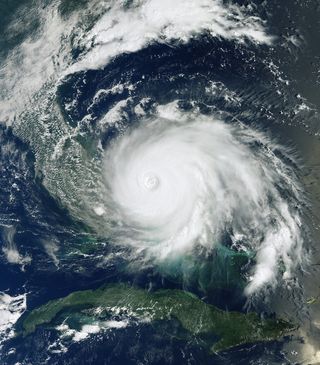Hurricane Dorian Looks Massive from Space As NASA Prepares for Impacts
Hurricane Dorian's clouds are staggering, a massive swirl of white surrounding the knotted eyewall at the storm's heart, in this image taken from space.
The image relies on data captured by the European Space Agency's Copernicus Sentinel-3 satellite, part of a constellation designed to provide environmental monitoring services. The image shows Hurricane Dorian at 11:16 a.m. EDT (1516 GMT) on Monday (Sept. 2).
At the time, the storm had been stalled over Grand Bahama Island and its neighbors for a full day. Its winds have weakened slightly, with maximum sustained gusts of 120 mph (195 km/h), making it a Category 3 storm.
Related: Watch Hurricane Dorian in Action in these NASA and NOAA Gifs

And the hurricane has finally started crawling to the northwest. But meteorologists are struggling to predict how much it will stay out to sea, and how fully the storm will bring its shattering winds and drenching rain to coastal communities along the Atlantic.
Chances are, Hurricane Dorian will at the very least graze the so-called Space Coast of Florida, including NASA's Kennedy Space Center, where personnel have spent nearly a week preparing for potential wind and rain from the storm. As the hurricane's edge creeped closer, Monday saw a barebones team of 120 staff arrive at Kennedy to ride out the storm.
Personnel from the 45th Space Wing of the U.S. Air Force, which is headquartered at nearby Cape Canaveral Air Force Station, are also on hand at NASA's Launch Control Center for the hurricane.
Sign up for the Live Science daily newsletter now
Get the world’s most fascinating discoveries delivered straight to your inbox.
The National Oceanic and Atmospheric Administration's National Hurricane Center is currently forecasting that Hurricane Dorian will inch up the Florida coast over the next few days, reaching Georgia on Thursday (Sept. 5) and North Carolina on Friday (Sept. 6).
People living in affected areas should follow the National Hurricane Center and local offices of the National Weather Service for the latest predictions about the storm.
- NASA Sees Hurricane Dorian from Space Station (Video)
- NASA's Kennedy Space Center Prepares for Hurricane Dorian
- Photos: Most Powerful Storms of the Solar System
Email Meghan Bartels at mbartels@space.com or follow her @meghanbartels. Follow us on Twitter @Spacedotcom and on Facebook.
Meghan is a senior writer at Space.com and has more than five years' experience as a science journalist based in New York City. She joined Space.com in July 2018, with previous writing published in outlets including Newsweek and Audubon. Meghan earned an MA in science journalism from New York University and a BA in classics from Georgetown University, and in her free time she enjoys reading and visiting museums. Follow her on Twitter at @meghanbartels.













